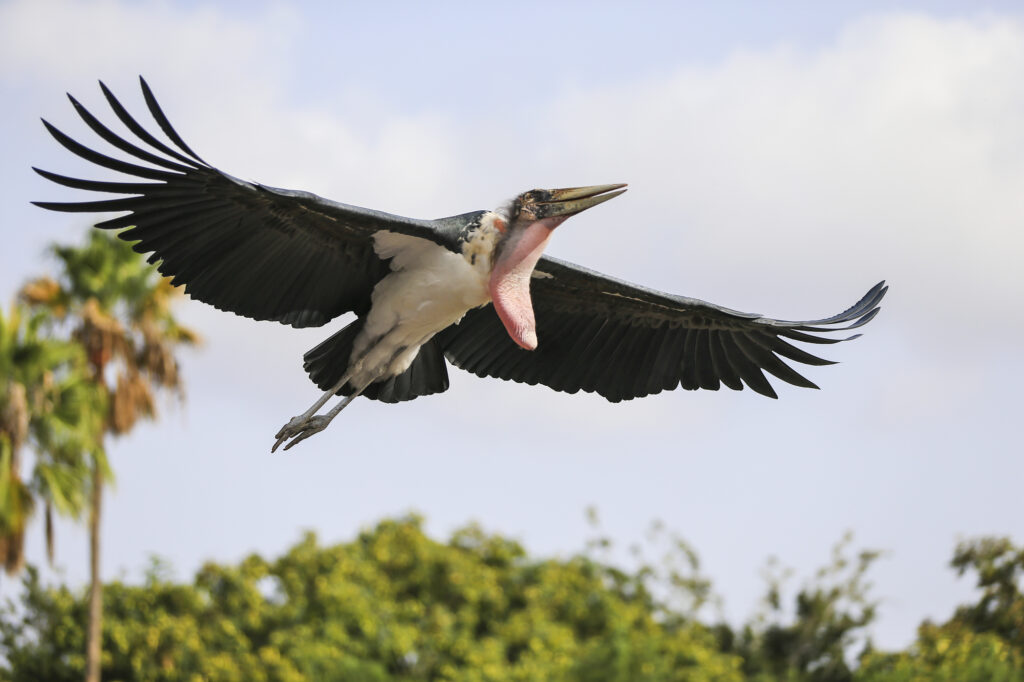Meet the Marabou stork–a big, ugly bird known as the “undertaker.”
It also has a uniquely large gular sac. Let’s learn more about this interesting African bird.
What Does the Marabou Stork Look Like?
First of all, Marabou storks are big! They reach up to 5 feet tall, weigh up to 20 pounds, and have one of the largest wingspans of any other living bird on earth. Their wingspan measures up to 10.5 feet, which is comparable to the Andean condor.
The Marabou stork is completely bald. Its back is black and its underparts are white. Its legs and wings are black, and both males and females look the same. It boasts a huge bill and a pink gular sac.
A gular sac is a pouch formed by the skin that connects the bird’s lower beak and neck. It is featherless. Perhaps the most iconic gular sac is that of a pelican; in a Marabou stork, it is pink and droopy–definitely difficult to miss!
Why Is the Marabou Stork Called the “Undertaker Bird”?
From behind, the Marabou stork looks like it is wearing a long black cloak. With its skinny frame and hunched posture, it gives a pretty ominous appearance.
At dusk, Marabou storks perch in trees and survey the area. This can be an intimidating sight.
Following around vultures is another trait that gives them their reputation of being associated with death and decay.
What’s the Deal With Marabou Storks and Fire?
That’s right–fire. Marabou storks are sometimes called “firebirds” because they take advantage of grass fires to find prey.
When a fire erupts in the grasslands in their territory, Marabou storks show up because it’s the perfect opportunity to flush out prey fleeing from the flames.
Talk about bad luck for the inhabitants of those grasslands when a fire breaks out! Imagine–you’re fleeing the heat and smoke, only to get swallowed up by a huge bird.
What Do Marabou Storks Eat?
The Marabou stork eats a pretty varied diet and will basically eat anything it can find. This includes fish, amphibians, reptiles, insects, feces, other birds, rodents, and even baby crocodiles.
If it fits in a Marabou stork’s bill, it will probably get swallowed up.
These storks find their food by soaring in the air, looking for carrion, scraps, and anything else that they can see. They will follow vultures around to find good sources of carrion.
Mating & Nesting Habits

A couple of times a year, females lay their eggs during the dry season, which is dependent upon where they live.
They swell and rattle their gular sacs to attract a mate. They typically mate for life, and both sexes work together to feed and raise their young.
Males gather sticks, twigs, and leaves to help the female build the nest, which they will sometimes build on top of a building. They will use the same nest for many years in a row.
They lay a clutch of 3-5 eggs, which incubate for quite a long time, compared to other birds. Marabou stork eggs don’t hatch for between 30-50 days.
Marabou stork chicks are completely helpless when they hatch and are entirely dependent upon their parents.
How Long Does the Marabou Stork Live?
Unfortunately, we don’t know much about its lifespan in the wild. However, in zoos, they live up to 20 years.
Where Do Marabou Storks Live?
Marabou storks are found throughout Sub-Saharan Africa. They have a very large range and are considered a species of Lowest Concern in terms of conservation. There are likely 10,000 sexually mature Marabou storks in Africa.
Their habitat includes savannas, rivers, lakes, and grasslands. They eat a lot of fish, so they tend to stay close to water. They are comfortable around people, so you will find them in cities and towns, too.
Their dietary preferences mean that they also gather in landfills, where they seek out dead animals and more.
Where Can I See a Marabou Stork?
If you can’t travel all the way to Africa, there are Marabou storks in a number of zoos all over the world.

